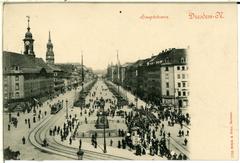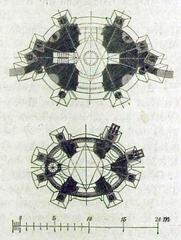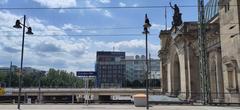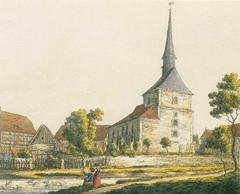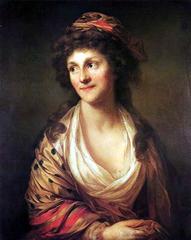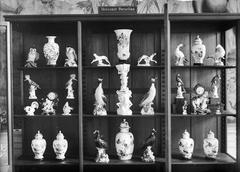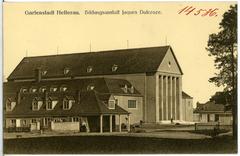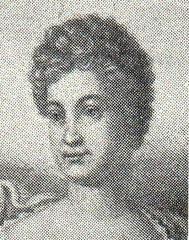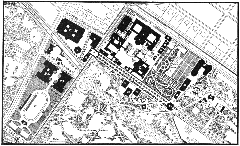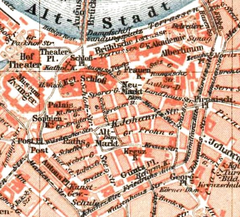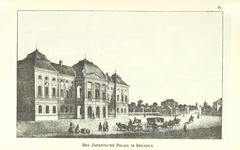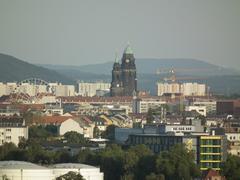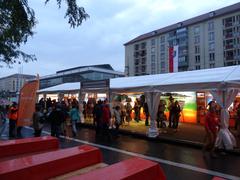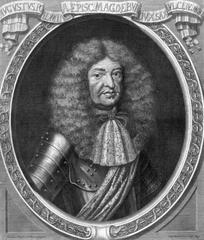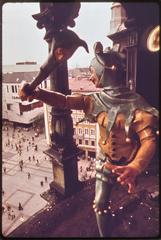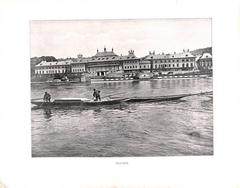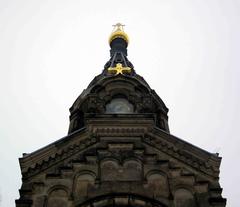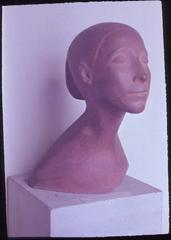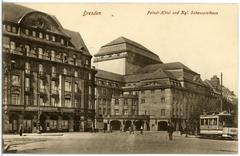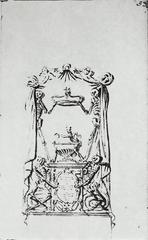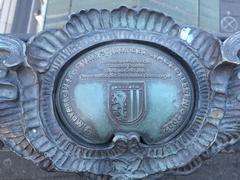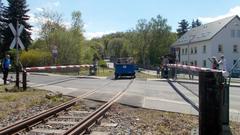
Palace of Dresden Grand Garden: Visiting Hours, Tickets, and Guide to Dresden Historical Sites
Date: 04/07/2025
Introduction
Nestled in the heart of Dresden, Germany, the Palace of Dresden Grand Garden (Palais im Großen Garten) serves as a magnificent testament to Baroque architecture and the city’s evolving cultural landscape. Commissioned in 1676 by John George III, Elector of Saxony, the palace and its extensive park—Großer Garten—blend the symmetry and grandeur of French Baroque with modern amenities and natural English landscape elements. Spanning approximately 180 hectares, this iconic site is both a historical monument and a vibrant urban oasis, drawing history enthusiasts, architecture aficionados, families, and nature lovers alike.
Whether your interests lie in exploring Saxony’s royal past, enjoying cultural events, or relaxing amid lush greenery, the Palace of Dresden Grand Garden offers an enriching experience. This comprehensive guide provides historical context, essential visitor information, and practical tips to help you make the most of your visit. For current schedules, events, and official updates, consult the Dresden tourism website and the Großer Garten official site.
Table of Contents
- Historical Overview
- Architectural and Landscape Features
- Cultural Significance
- Visitor Information: Hours, Tickets, Accessibility
- Getting There and Best Time to Visit
- Activities and Attractions
- Special Events and Seasonal Highlights
- Family-Friendly Features
- Park Regulations and Visitor Etiquette
- Frequently Asked Questions (FAQ)
- Conclusion
- References and Further Reading
Historical Overview
Origins and Early Development (1676–1814)
Commissioned by John George III in 1676, the Palace of Dresden Grand Garden was constructed as a pleasure palace for court festivities, hunting, and summer retreats (Wikipedia). Designed in the early Baroque style, the garden and palace reflected ideals of order and aristocratic display, modeled after the French gardens of Versailles. The formal layout was characterized by geometric parterres, water features, and grand axes converging on the central palace.
Transition to Public Park (1814–19th Century)
In 1814, the Großer Garten transitioned from exclusive royal grounds to a civic park, coinciding with Dresden’s urban expansion (Wikipedia). English landscape elements—curving paths, naturalistic plantings—were introduced, and new attractions such as the Dresden Zoo (1861) and Botanical Garden (1893) further enriched its recreational value (grosser-garten-dresden.de).
20th Century: War and Restoration
Both palace and park sustained significant damage during World War II air raids. Post-war reconstruction prioritized the restoration of historical features, while scars of conflict remained visible for decades (dokmimarlik.com). The opening of the Dresden Park Railway in 1950 marked a new era of public engagement and family-friendly attractions (grosser-garten-dresden.de).
Contemporary Significance
Today, the Großer Garten stands as one of Europe’s largest and most significant Baroque gardens, integrating historical, cultural, and modern features, including the innovative Volkswagen Transparent Factory at its northwest edge (Wikipedia).
Architectural and Landscape Features
- Palace (Sommerpalais): An early Baroque masterpiece with symmetrical facades, ornate stucco, and grand staircases. The palace served as a venue for lavish gatherings and today hosts concerts and exhibitions (evendo.com).
- Baroque Gardens: The central parterre gardens maintain their original geometric design, surrounded by formal lawns, tree-lined avenues, and sculptural fountains (grosser-garten-dresden.de).
- English Landscape Elements: Outer park areas feature winding paths, natural woodlands, and picturesque lakes, blending formal and informal styles.
- Ornamental Features: Statues, water features, and pavilions enhance the park’s visual appeal.
Cultural Significance
- Historical Role: The palace was a hub for Saxon court events, reinforcing royal prestige. Today, cultural events like the Dresden Schlössernacht and “Offenes Palais” series keep this legacy alive (palais-grosser-garten.de).
- Community Space: Since the 19th century, the park has served as Dresden’s “green heart,” hosting concerts, festivals, and public gatherings (germanywithamy.com).
- Educational Value: Guided tours, exhibitions, and educational programs explore the art, architecture, and horticultural techniques of the Baroque era (evendo.com).
Visitor Information: Hours, Tickets, Accessibility
Visiting Hours
- Großer Garten Park: Open daily, year-round, from dawn to dusk. Admission is free (official Dresden tourism website).
- Palace (Sommerpalais): Open for special events, exhibitions, and guided tours. Check the official website for current schedules.
- Dresden Park Railway: Operates April–October, with daily service in summer and weekends/holidays in spring and autumn (grosser-garten-dresden.de).
Tickets and Pricing
- Park Entry: Free.
- Palace Events/Exhibitions: Ticket prices vary; general admission is about €8 for adults, with discounts for students, seniors, and children under 6 free (palais-grosser-garten.de).
- Dresden Park Railway: Standard fares €2–€3, with group/family discounts and annual cards available.
- Zoo and Botanical Garden: Separate admission fees apply.
Accessibility
- Paths: Main avenues are paved and suitable for wheelchairs and strollers; some natural trails may be uneven.
- Facilities: Accessible restrooms and assistance available.
- Transport: The park is easily reached by tram (lines 1, 9, 10, 13) or bus; parking and cycling routes are available (dvb.de).
Getting There and Best Time to Visit
Directions
- Address: Hauptallee 5, 01219 Dresden, Germany.
- Public Transport: Trams 1, 9, 10, 13 (“Großer Garten” or “Zoo” stops); 20-minute walk from Old Town.
- Parking: Available near main entrances; public transport is recommended during peak times.
- Cycling: Dedicated bike paths lead directly to the park.
Best Time to Visit
- May–October: Ideal for full bloom, outdoor events, and railway operation (TravelSetu).
- Spring/Autumn: Milder temperatures, fewer crowds, vibrant colors.
- Winter: Park remains open; palace and railway may have limited hours.
Activities and Attractions
- Walking, Jogging, Cycling: Extensive flat paths and a popular 5 km perimeter loop (greatruns.com).
- Picnicking: Open lawns and shaded groves welcome picnickers.
- Dresden Zoo: Home to over 1,500 animals, ideal for families.
- Botanical Garden: Features over 10,000 plant species and themed landscapes.
- Park Railway: Miniature train circuiting the park, operated by youth volunteers (Atmoph).
- Cultural Events: Open-air concerts, art exhibitions, and seasonal festivals.
Special Events and Seasonal Highlights
- Dresden Schlössernacht: Annual “Night of the Palaces” with music and illuminations.
- Palais Sommer: Summer festival with classical music, yoga, and film screenings.
- Seasonal Blooms: Spring tulips and autumn foliage create stunning vistas.
Family-Friendly Features
- Playgrounds: Well-equipped for children throughout the park.
- Railway: Especially popular with families, offering an engaging tour of the grounds.
- Baby Facilities: Changing tables and stroller-friendly paths.
Park Regulations and Visitor Etiquette
- Pets: Dogs allowed on leashes; small fee applies for dogs riding the railway.
- Cycling/Skating: Permitted on designated paths only.
- Barbecues/Open Fires: Not allowed.
- Drones/Model Aircraft: Prohibited.
- Nature Protection: Do not pick flowers or disturb wildlife (Großer Garten regulations).
Frequently Asked Questions (FAQ)
Q: What are the visiting hours?
A: The park is open daily, year-round. The palace and railway have specific schedules—check the official site for details.
Q: Are tickets needed for entry?
A: Park entry is free. Tickets are required for palace events, the zoo, botanical garden, and park railway.
Q: Is the park accessible for wheelchairs and strollers?
A: Yes, main paths and facilities are accessible.
Q: How do I get to the park?
A: Use tram lines 1, 9, 10, or 13; parking and bike paths are also available.
Q: Are dogs allowed?
A: Yes, leashed; a fee applies for dogs on the railway.
Q: What is the best time to visit?
A: May–October for full access and events; spring and autumn for tranquility.
Conclusion
The Palace of Dresden Grand Garden is more than a historical monument: it is a living symbol of Dresden’s resilience, artistry, and community spirit. Its accessible green spaces, cultural events, and family-friendly attractions make it a must-visit for anyone exploring the city. To ensure the best experience, check current hours, ticket options, and event schedules in advance, and consider joining a guided tour or downloading the Audiala app for audio guides and real-time updates.
For further information, visit the official Großer Garten website and the Dresden tourism portal.
References and Further Reading
- Dresden tourism website
- Großer Garten official site
- Großer Garten Wikipedia Entry
- Evendo Dresden Grand Garden
- Atmoph: Grand Garden Palace
- Official Service and Ticket Info
- TravelSetu Dresden
- Weather2Travel Dresden
- Great Runs: Grand Garden of Dresden
- GermanyWithAmy Dresden Guide
- Dokmimarlik Dresden Reconstruction
- The Crazy Tourist: Dresden
For curated itineraries and real-time updates, download the Audiala app and follow us on social media for the latest on Dresden’s attractions and events!
















